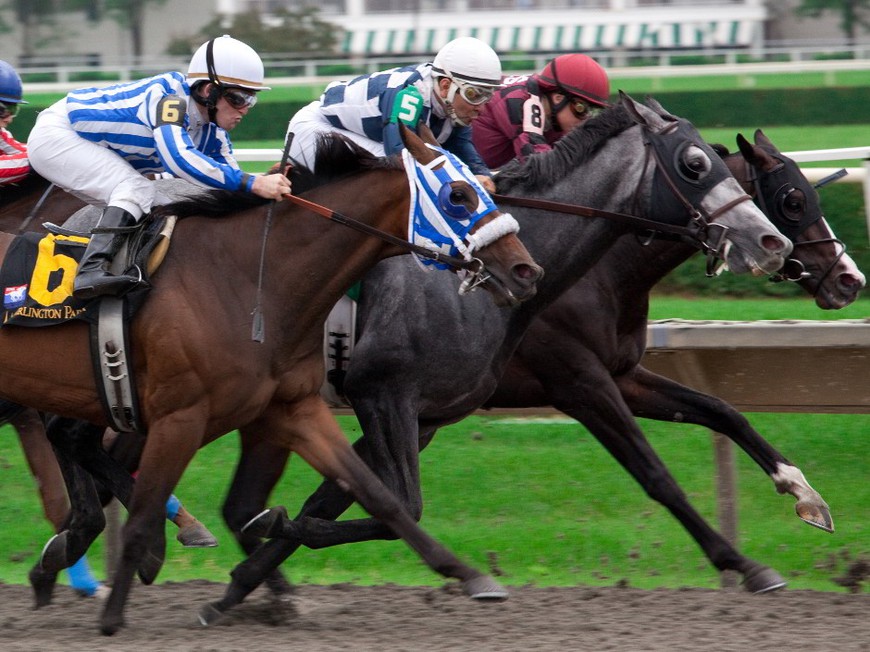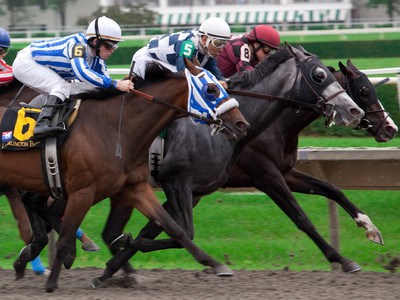

Any gambling endeavor involves risk. Learning to navigate that risk and identify situations that offer value is the key to becoming profitable. In horse racing, people spend decades chasing angles, trying different betting strategies, and developing algorithms, while paying “tuition” with each failure. Wouldn’t it be great to see what picks the best handicappers make? In many horse racing tournaments this is actually possible.
Choose a Site
Get a $100 sign up bonus at twinspires.com
There are several good options for playing horse tournaments. DRFBets.com, Horsetourneys.com, HorsePlayers.com, and Derby Wars are just a few of them. All of these sites offer similar formats and choosing one is a matter of personal preference. I currently prefer DRFBets.com for their daily variety of options.
I recommend starting with “all-in”/“pick and pray” tournaments. In these tourneys you are required to pick a winner (and usually an alternate, in case of a scratch) for predetermined races, and all picks must be submitted before the start of the 1st race in the sequence. Alternative tournament types allow for many other factors which are beyond our scope for this week. All-in/Pick and pray tournaments focus almost exclusively on handicapping which makes them a perfect place to start.
In all-in tournaments you pay the entry fee and make $2 mythical win and place bets on your selections. The payouts are often “capped” at a certain dollar amount to discourage fluke winners from a single longshot. A normal cap would be a $42 win and $22 place payout. If you select a 50-1 winner, your tournament score will only be increased by the cap amounts of $42 for the win and $22 for the place. The highest total at the end wins.
All-In Leaderboards as a Tool
Sites such as DRFBets will allow members to view the leaderboards of past tournaments. This information is invaluable for 2 main reasons.
First, you can see the historical scores that won prior tournaments. In an 8, 10, or 12 race tourney, you can evaluate how much is needed per race in order to be competitive. If the past five 8-race tourneys were won with an average total of $88, you can infer that you must make at least $11 per race and adjust your selections accordingly. It would make no sense to play all 2-1 favorites because even if you hit several of them, you are not likely to win the tournament. The other price plays that won would easily beat your short prices.
The second and more important benefit of the leaderboards is that you can view the picks of all players. Just like in poker, it is no coincidence that the same players tend to be at the top of the leaderboards time after time. Once you have identified a few of the top players, you can compare your picks to theirs and reverse-handicap races to see what they saw, and what you may have missed. It’s like seeing the hole cards in televised poker and how a hand is played.
If handicapping champions Michael Beychock, Christian Hellmers, or Jonathon Kinchen are in your all-in tournament, you can see exactly who they picked for each race. You can then go back to your resources to try and figure out how they came to each conclusion.
Building Confidence to Play Longshots
The holy grail of handicapping is the ability to pick longshots. But longshots don’t win every race. In a real money environment it is easy to get frustrated, or even worse, go broke, before your longshot comes in. Tournaments provide the ability to gauge your ability to pick big prices without the financial burden while learning.
Sometimes it is hard to learn to pull the trigger on a big price when playing for real money. In an all-in tournament scenario, you can play ALL longshots, hoping to hit a couple of them, and it will only cost you the tournament entry fee. The learning curve is much steeper when you have some skin in the game.
Get a $100 sign up bonus at twinspires.com
Another insight from the leaderboards is identifying longshots you should have played versus those who ran an unpredictable surprise race. When a 20-1 shot wins a race and 7 of 30 players in a tournament had it, there was something that you should have seen. If nobody in the tournament played that longshot, it may have been a fluke race.
What I have laid out here is not a strategy for winning tournaments. It is a strategy for using all-in tournament play and the resources provided in them as tools to improve your handicapping. It’s as close to having a handicapping mentor as I could find.

